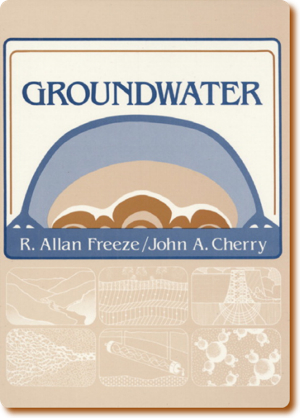Archive for the ‘techingGroundwater’ tag
Hydrogeology Books
Mirko asked me today what books I would recommend in the “hydrogeology – area”. This is a relatively broad area. However, I thought it might be useful to some of you to write up a list of books that I remember I found useful when studying hydrogeology at a Masters level.
Applied Hydrogeology by Fetter (2001)
This is the book I learned most of my physical hydrogeology from. It’s ok.

Freeze and Cherry, 1979
This is a classic. No doubt. I think it’s really well written. There are lot’s of stories circulating about page 29, but hey, what a great page. Please note, that the cover is upside down… Most importantly I like the clearness in its style.
also by Fetter, there’s a book Contaminant Hydrogeology (1998)
. I’ve neither used it nor do I own it, but people tell me it’s ok.
When I learned contaminant hydrogeology, I guess I used a combination of three books: “Geochemistry, Groundwater and Pollution” by Appelo and Postma (2005)
, “Aquatic Chemistry: Chemical Equilibria and Rates in Natural Waters” by Stumm and Morgan (1995)
and “Dense Chlorinated Solvents” edited by Pankow and Cherry (1996)”.
For the unsaturated zone I can highly recommend “Environmental Soil Physics: Fundamentals, Applications, and Environmental Considerations: Fundamentals, Applications and Environmental Considerations” by Hillel (1996)
– very simple and “to the point” explanations! Another recommendation, however I don’t think you can get it anymore, is “Mechanics of heterogeneous fluids in porous media” by Corey (1977). “Corey” as in Brooks-Corey relationship.
On the practical side, I can recommend the legendary “Groundwater and Wells” by Driscoll (1986)
(as a reference), “Analysis and Evaluation of Pumping Test Data” by Kruseman and de Ridder (1990)
for hydraulic aquifer analyses, as well as for general field-work (as a useful reminder for things not to forget): “Manual of Applied Field Hydrogeology” by Weight and Sonderegger (2000)
After having taken the short course that I keep mentioning, I turned into a big fan of “Dynamics of Fluids in Porous Media” by Jacob Bear (1972)
. Jacob Bear has also noteworthy other books
, and “Modeling Groundwater Flow and Contaminant Transport (Theory and Applications of Transport in Porous Media)”
to be released in October.
There are a variety of modelling-related books, but I’ll cover those the next time!
Jacob Bear Short Course – Day 1
As I mentioned before, I am currently attending a short course presented by Jacob Bear. The first day with ~6 hours of lecturing is over. These hours were some of the fastest lecturing hours I’ve experienced in my academic life to date. As I can tell so far, the advantages of such an experienced lecturer are:
- He has explained these things many times before, so he knows where he is coming from and where he’s going to;
- This experience is also clear in the way he explains things — he knows what to emphasize;
In terms of his lecturing style I like
1) that he stresses things clearly either by pointing them out directly or by repeating them. The repetition might be directly after the first time he mentions something, or the repetition might be some significant amount of time after the first mention;
2) the clearness how things evolve. At any point it is clear why we are discussing what we are discussing and where we are coming from. Mostly it is even clear where we are going to;
3) The way of his explanations. Usually the explanation evolves from a usually very basic question. How basic the questions are is sometimes startling. However, the answers to such seemingly simple questions provide quite a bit of insight:
- What is a porous medium?
- What is a continuum approach?
- What is a phase, what is a component?
- Why do we not solve “flow” with the Navier-Stokes equation? After all, we do know essentially everything at a macroscopic level!
- What is a model?
- What is a fluid? — The abstraction of “fluid” from “molecules” is a very nice comparison with the deduction of a REV!
- What is a water table? — If I learned one thing at Waterloo, I think I would choose this 🙂
After these basic definitions, also including a discussion of modelling and the modelling process, we spent a lot of time of deriving the advection-dispersion equation, from two angles. – from a Darcy-angle and – from a momentum-equation angle.
The beautiful thing was how Jacob Bear showed, from first principles how the advection-dispersion equation is obtained under which assumptions. Again, this is nothing new, but new was at what basic level we started. Some of the averaging techniques Jacob Bear briefly showed us, and which were written down by Bear and Bachamat (1990), might deserve some deeper investigation.
Also interesting is the concept to derive basic equations for any extensive quantity, add the above mentioned averaging rules, and substitute the desired quantity and you’re desired description is right there. Nice.
Tomorrow, we’ll be dealing with one of my current favourite topics, dispersion.